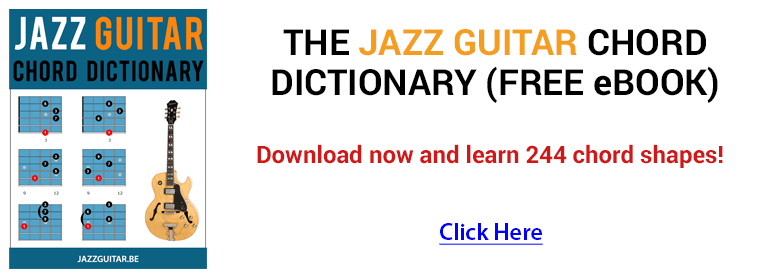-
l C6 I Em7 A7 l Dm7 G7 C6 l X2
l Em7b5 Bb7 A7 l - l Dm7 Ab7 G7 l - l
l C7 C9/E l F6 F#o7 l C6/G G7 C6 l - l
How you guys usually tackling improv on this tune? Key centers, chord tones on each chord, major scale, blues scales? Inquiring minds want to know.

Last edited by Double 07; 01-02-2012 at 09:52 PM.
-
01-02-2012 09:50 PM
-
I think key of C all the way through, adding the notes necessary to get the VI7 and the other non-diatonic chords. I find that bebop vocabulary sounds best on this tune.
-
You can alter St.T. in a lot of ways. i.e.:
Part A:
I C I C#7dim I Dm7 G7 I C I
or
I C I E7 Eb7 I D7 Db7 I C I
Part B:
I C B Bb I A7 I Dm7 A7 Ab7 I G7 I
Part C:
I C C#dim I Dm7 D#dim I Em7 G7b9 I C I
You can stay in C just adding some notes (C#s and than kind) where required. You can shift chromatically with these chord movements, you can play lots of diminished stuff here and there, very forgiving tune, if you keep it grooving.
Edit: Now I remember once hearing a guy (sax?) playing strictly blues-scale over the whole tune, sounded cool!Last edited by DonEsteban; 01-03-2012 at 04:55 AM. Reason: Forgot something
-
Some ideas to play:
1 - A minor pentatonic whole issue
2 - A minor pentatonic in Part A and C - F # minor / E minor in Part B
3 - A minor pentatonic in Part A and C - D minor / Db minor (chromatic approach) in part B
4 - A minor pentatonic in Part A and C - C # º / B º arpeggio for Part B.
Here's a sample audio:
(Playing every instance)
DivShare File - SAINT TOMAS.mp3
-
I stay in mainly in C adding chromatic notes and trying to target chord tones (but not all the time)
here is a take I did a while back:
stTomas.mp3 - File Shared from Box - Free Online File Storage
-
C is the tonic. Over E-7 A7 D-7 I would play D MM. G7, would be G altered scale.
 Originally Posted by Double 07
Originally Posted by Double 07
E-7b5 Bb7 A7, I would play GMM
C7 C9/E I play F
F6 F#Dim I would play F#alt
C6/G G7 C6 I would play G alt to resolve the G into C
Overall my use of MM would be snippets of phrases and sequences that always lead back to the tonic.Last edited by brwnhornet59; 01-03-2012 at 02:01 PM.
-
Hi,
IMO It's a very difficult sounding tune for guitar as it is more shaped for piano or sax
I've constantly tried to simplify my playing on it and above all rythm is really king on that tune. You will more please the audience if you play good designed repetition motifs than complicated lines.
So i play basically in Cmajor with some alterations, which is in my opinion the best way to stay on the carabean feeling.
Of course just don't miss the G7 at the end of the first phrases
then the A7 on the B part and of course the final turnaround which is so strong
Anyway altough I write that when I play it I'm alway going into more sophisticated stuffs, and bluesy Cm pentatonic and so on...
It's also great fun when you play "outside" as would do a cuban pianist
Hope it helps
L.
-
 Originally Posted by jayx123
Originally Posted by jayx123
Nice improv Jay.
-
thanks Kman, Its a fun tune.
-
Okay cool BH. Hey if you can play all of those scales over this tune at performance speed you must have some fast fingers. Especially over the first eight measures.Hats off to ya, I'd love to hear it.GMM on the E7b5 Bb7 A7 doesn't work for me. You really like "outside" sounds I take it. Alright
 Originally Posted by brwnhornet59
Originally Posted by brwnhornet59

I hear it more like augusjazz, a great tune to practice coming up with cool sounding lines using pentatonic's and jazzy/bluesy riffs on chord changes, for most of the tune anyway.
A minor pent - whole tune.
E minor pent for some additional flavor in places
The E Bb A - D Ab G section is pretty much wide open
If I'm feeling real daring I might try D min pent over E Bb A
over E Bb A
Then E minor Pent over D Ab G
The F#o in the turnaround is just a passing chord on the way to G13 isn't it?
Then there's the usual chromatic passing tones
Chord tones off of the I and IV
Maybe C minor Pent on C Em A7 for some real spicy flavor
Augusjazz on the reharm tip I love it
Last edited by Double 07; 01-04-2012 at 08:00 AM.
-
Nah man. Just snippets. 1 measure of 1/4 or 1/8 note sequences for flavor. No reason YOU couldn't do that, nothing fancy. Open your mind and many things will become possible for you. It is all about how you look at it.
 Originally Posted by Double 07
Originally Posted by Double 07
D MM has 1 altered note from C major, So looking at it as putting a C# in as a passing tone, that is all it is.
G MM, (G dorian natural 7), over the E-7b5 Bb7 , which is in the key of F for a sec, is again 1 altered note, F#. Just a chromatic, easy. GMM over A7, just a secondary dom VI7, gives that b5 b9 #9 sound for the turn around. The #9, (C), keeps it stable segueing beautifully into the tonic, again easy and used all of the time. D MM would work really well to. There is nothing way outside about it. No gymnastics involved. I bet you throw chromatic's in here and there don't you? JayX123 did. Folks invoke these scales all of the time and don't even realize it.
I am not from the chromatic passing tone club. I analyze everything and draw from the pool of notes using modal interchange, no big deal. MM is not usually used as a steady improv scale in these tunes. Knowing their power and learning how to use them, especially in a ii V turnaround, is the key to using them effectively.
Look at what DonEsteban posted. His method does the same thing, he just calls them chromatic passing tones.
Amund said bebop scales were best, again more chromatic passing tones. I think you will find all of these fine players are saying the same thing. Make sense?
C is the tonic to be stressed, with chromatic passing tones. A and E minor Pent serves you well, but there are always other choices.

Last edited by brwnhornet59; 01-04-2012 at 09:50 AM.
-
Very cool BH.
 I'm gonna have to start calling you "fast fingers" lol
I'm gonna have to start calling you "fast fingers" lol
Definitely a fun tune, lots of options really.
Nice playing Jayx123 Did u make that backing track with BIAB or the software listed in your siggy?
Did u make that backing track with BIAB or the software listed in your siggy?
Last edited by Double 07; 01-04-2012 at 08:09 AM.
-
LOL, I would not play any faster than Jayx did. No need for it. But you got the idea.

-
007 - thanks, the play back is done with BIAB. Regarding what BH said you think of all these at practice time after a while your ears will eventually absorb the sounds and it will just happen.
-
BTW, good job Jayx!
 Originally Posted by jayx123
Originally Posted by jayx123

-
thanks BH :-)




 Reply With Quote
Reply With Quote



Bending
Yesterday, 08:56 PM in Guitar Technique